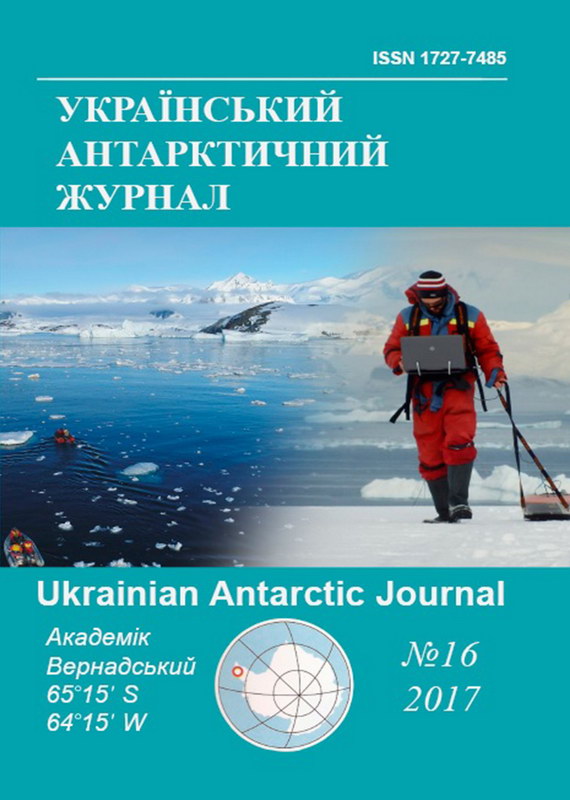Анатомічна і функціональна характеристика листковoї пластинки Deschampsia аntarctica (Poaceae), що росте на Аргентинських островах
- Deschampsia antarctica,
- анатомічна структура,
- ультраструктура,
- перекисне окислення,
- лігнін
- адаптація ...Більше

Ця робота ліцензується відповідно до Creative Commons Attribution-NonCommercial-NoDerivatives 4.0 International License.
Анотація
Метою роботи було проведення порівняльних досліджень анатомічної структури та вмісту активних форм кисню (АФК) в листках Deschampsia antarctica (Poaceae), що росте в екстремальних кліматичних умовах Антарктики (острови Скуа і Галіндез). Для досліджень анатомічної структури та ультраструктури поверхні листків використовували методи світлової та скануючої електронної мікроскопії. Локалізацію монолігнінів визначали за допомогою цитохімічного методу фарбування тканин, вміст АФК в листках – методом реєстрації спонтанної хемілюмінесценції (СХЛ). Результати засвідчують ідентичність анатомічної структури та ультраструктури поверхні листків у рослин, зібраних в різних місцезростаннях. Локалізація в листках двох монолігнінів (сирингіла та гваяцила) в клітинних стінках листків досліджених рослин була також подібною. Встановлено, що сирингіл, в основному локалізований в клітинних стінках епідермісу, підтримуючи їхню механічну міцність, а гваяцил, що забезпечує гнучкість стінок, локалізований в основному в стінках клітин мезофілу і судин. Вміст сирингілу в стінках клітин епідермісу перевищував рівень гваяцилу у 6–8 разів. Рівень СХЛ в листках D. antarctica дорівнював середньому значенню люмінесценції листків інших видів в нормальних умовах. Можна зробити висновки, що отримані результати можуть бути показниками адаптації цього виду до екстремальних умов. На нашу думку, посилення уваги до вивчення клітинного метаболізму та його регуляції у рослин D. аntarctica сприятиме подальшому пізнанню механізмів їхнього виживання в умовах Прибережної Антарктики.
Посилання
- Amosova, A. V., Bolsheva, N. L., Samatadze, T. E., Twardovska, M. O., Svyatoslav, A., Zoshchuk, I.O., Badaeva, E. D., Kunakh, V. A., Muravenko, O.V. 2015. Molecular cytogenetic analysis of Deschampsia antarctica Desv. (Poaceae), Maritime Antarctic. PLOS. https://doi.org/10.1371/journal.pone.0138878.
- Ayala, A., Mucoz, M.F., Argüelles, S. 2014. Lipid peroxidation: production, metabolism, and signaling mechanisms of malondialdehyde and 4-hydroxy-2-nonenal. Oxidative Medicine and Cellular Longevity. ID 360438. https://doi.org/10.1155/2014/360438
- Chwedorzewska, K. J., Gielwanowska, I., Szczuka, E., Bochenek, A. 2008. High anatomical and low genetic di-versity in Deschampsia antarctica Desv. from King George Island, the Antarctic. Pol. Polar Res., 29, 377-386.
- Dietz, K.-J. 2008. Redox signal integration: from stimulus to networks and genes. Physiol. Plant.,133, 459-468. https://doi.org/10.1111/j.1399-3054.2008.01120.x.
- Foyer, C. H., Noctor, N. 2003. Redox sensing and signalling associated with reactive oxygen in chloroplasts, peroxisomes and mitochondria. Physiol. Plant.,119, 355-364. https://doi.org/10.1034/j.1399-3054.2003.00223.x.
- Gielwanowska, I., Szczuka, E. 2005. New ultrastructural features of organelles in leaf cells of Deschampsia antarctica Desv. Polar Biol., 28, 951-955. https://doi.org/10.1007/s00300-005-0024-2.
- Gielwanowska, I., Szczuka, E., Bednara, J., Gorecki, R. 2005. Anatomical features and ultrastructure of Deschampsia antarctica (Poaceae) leaves from different growing habitats. Ann. Bot., 96, 1109-1119. https://doi.org/10.1093/aob/mci262.
- Jadko, S.I. 2012. Ranneye uvelicheniye soderzhaniya aktivnykh form kisloroda I aktivnosti askorbat peroksi-dazy I katalazy v list'yakh Arabidopsis thaliana pri osmoticheskom i oksidativnom stessakh [Early increasing the content of reactive oxygen species and the activity of ascorbate peroxidase and catalase in leaves of Arabidopsis thaliana plants under osmotic and oxidative stresses]. Visnyk Kharkiv. natsionalnogo agrarnogo universytetu. Seriya Bioilogiya.[The Bulletin of Kharkiv National Agrarian University. Ser. Biology]. 3(27), 58-64.
- Jadko, S. I. 2015. Histone deacetylase activity and reactive oxygen species content in the tissue culture of Arabidopsis thalianaunder normal conditions and development of acute osmotic stress. Ukr. Biochem. J., 87, 57 - 62. https://doi.org/10.15407/ubj87.03.057.
- Kolupaev, Iu.E., Karpets ,Iu.V. 2014. Aktyvnye formy kisloroda i stressovyi syhnalynh u rastenyi [Reactive oxygen species and stress signaling in plants]. Ukr. Biochem. J., 86 (4), 18-35. https://doi.org/10.15407/ubj86.04.018.
- Mittler R., Vanderauwera S., Gollery M., Breusegem F.V. 2004. Reactive oxygen gene network of plants. Trends Plant Sci., 9, 490-498. https://doi.org/10.1016/j.tplants.2004.08.009.
- Moller, I. M., Sweetlove, L. J. 2010. ROS signaling-specificity is required. Trends Plant Sci., 15, 370-374. https://doi.org/10.1016/j.tplants.2010.04.008.
- Romeo, M., Casanova, A., Iturra, G., Reyes ,A., Montenegro, G., Alberdi, M. 1999. Leaf anatomy of Deschampsia antarctica (Poaceae) from the Maritime Antarctic and its plastic response to changes in the growth conditions. Revista Chilena de Historia Natural, 72, 411-425.
- Santos, C.V., Rey, P. 2006. Plant thioredoxins are key actors in the oxidative stress response. Trends Plant Sci., 11, 329-334. https://doi.org/10.1016/j.tplants.2006.05.005.
- Szczuka, E., Gielwanowska, I., Leszczuk, A., Domaciuk, M., Pietrusiewicz, J., Bednara, J. 2013. Specific ultrastructure of the leaf mesophyll cells of Deschampsia antarctica Desv. (Poaceae). Ann. Univ. Mariae-Curie-Sklodowska, sectio C - Biologia, 68, 25-33. https://doi.org/10.2478/v10067-012-0031-y.
- Tarusov B. N., Veselovskii V.A. 1978. Sverkhslabye svechenyia rastenyi i ikh prykladnoe znachenie. Moskva: Izdatelsvo MHU, 151.
- Zuciga, G. E., Alberdi, M., Corcuerm, L. 1996. Non-structural carbohydrates in Deschampsia antarctica Desv. from South Shetland islands, Maritime Antarctic. Environ. Experim. Botany, 36. 4., 393-399. https://doi.org/10.1016/S0098-8472(96)01026-X.
- Zunica-Feest, A., Inostroza, P., Vega, M., Bravo, L., Corcuera, L.J. 2003. Sugars and enzyme activity in the grass Deschampsia antarctica. Antarctic Science, 15, 483-491. https://doi.org/10.1017/S0954102003001597.

